Your Net Promoter Score is like a beautiful flower.
Leave it on its own, and it will undoubtedly wither and fade away, having little to no impact on your life.
Check it regularly and water it carefully; the flower will bloom, bringing you happiness and elevating your home’s design.
Let’s go back to business.
The NPS is of little use when you ignore it. However, analyzing, acting on it, and tracking its progress can blast your business into new horizons.
This NPS guide offers a clearer understanding of the Net Promoter Score, zeroing in on its interpretation. Read on and discover the meaning of “good” and ”bad” Net Promoter Scores, the idea behind the NPS score scale, and compelling use cases of the NPS.
What Is a Net Promoter Score (NPS) Scale?
The (Net Promoter Score) NPS score Scale is fundamentally the instrument to identify your NPS score.
Typically, the scale ranges between one and ten, each number corresponding to your customer groups: detractors, passives, and promoters.
The most common NPS score scale ranges between 1 and 10, but you can deploy a 1 to 5 model – depending on your NPS questions.
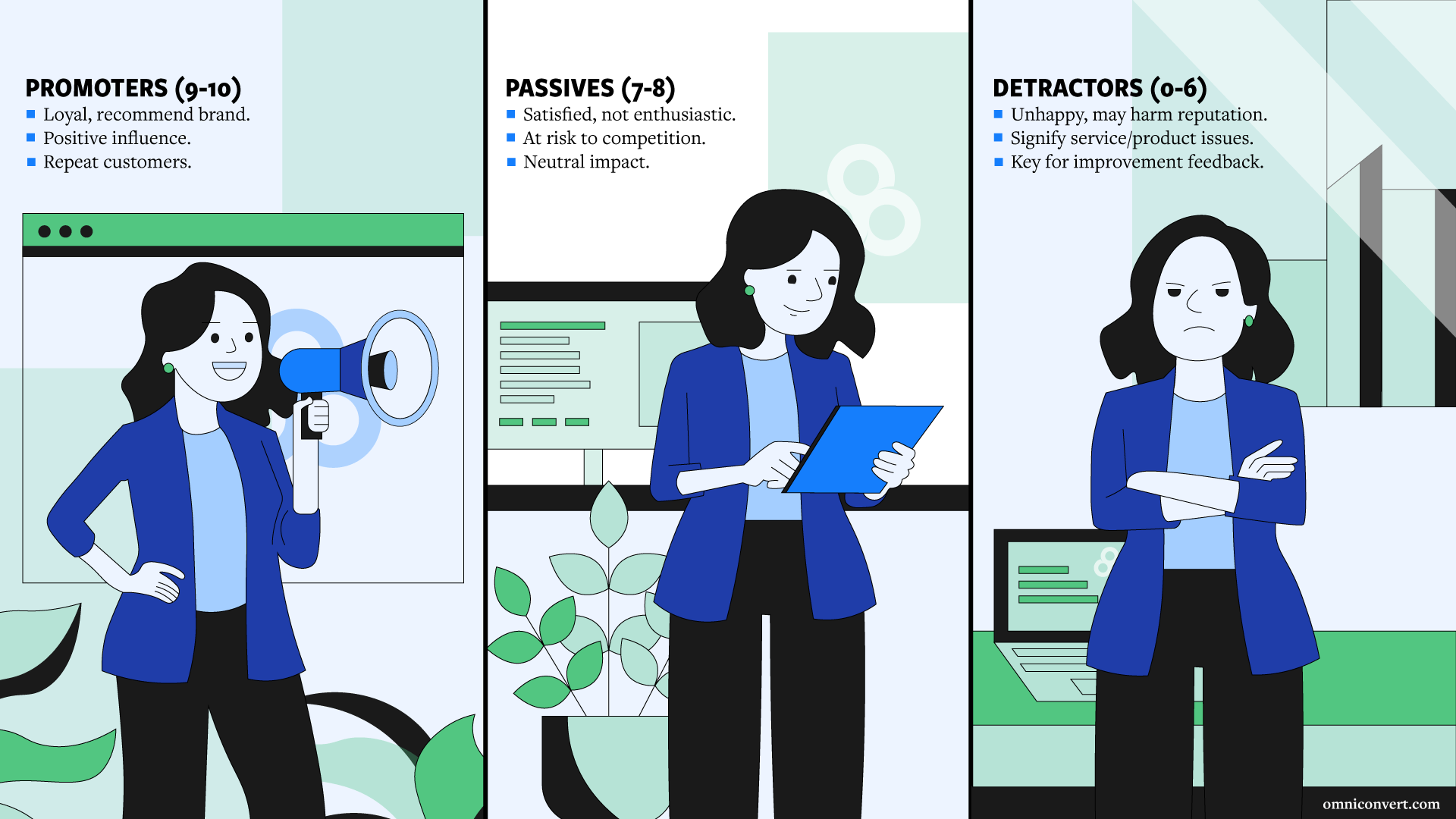
Look at the NPS score scale as you’d look at a compass; it settles the direction of your eComm model concerning the customer experience & services.
When the business doesn’t work as you hoped, tweaking the business model can become chaotic and overwhelming.
The NPS and other customer experience metrics serve to prioritize, highlight, and give meaning to your endeavors, placing the voice of the customer in the decision-making position.
Net Promoter Score Scale: detractors, passives, promoters
The Net Promoter Score helps you determine the percentage of customers who might recommend your brand to their communities.
The scores are determined by NPS surveys and account for your customers’ opinions exclusively. It’s a tried-and-true metric, as it relies solely on customer input and doesn’t require any guessing from your teams.
An NPS survey consists of a scoring question where customers rate their willingness to recommend your brand on a numbered scale.
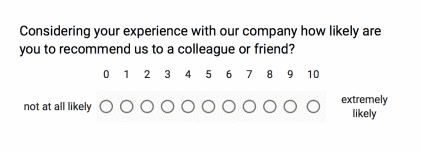
After you calculate Net Promoter Score, depending on the ratings, customers will fall into one of three categories:
NPS Promoters

Customers who scored 9 and 10 (or 5 if you’re using a 5-point scale) are your NPS Promoters.
Promoters are shoppers who were pleased with the experience and might recommend you, given a chance. These people can become brand ambassadors and provide free (and effective) advertising for your brand.
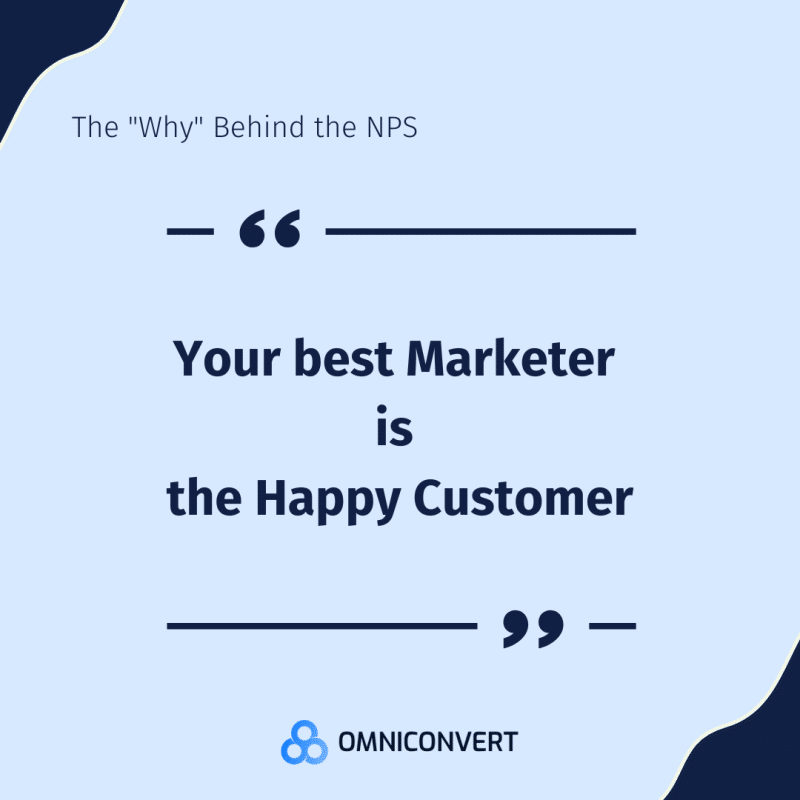
To ensure continued customer loyalty from your Promoters, you must continue impressing and delighting them with your brand’s experiences.
It’s helpful to identify which aspects of their shopping and delivery experience influenced their scores. Doing this allows you to place your strong points and be mindful of them over your relationship with your promoters.
NPS Passives
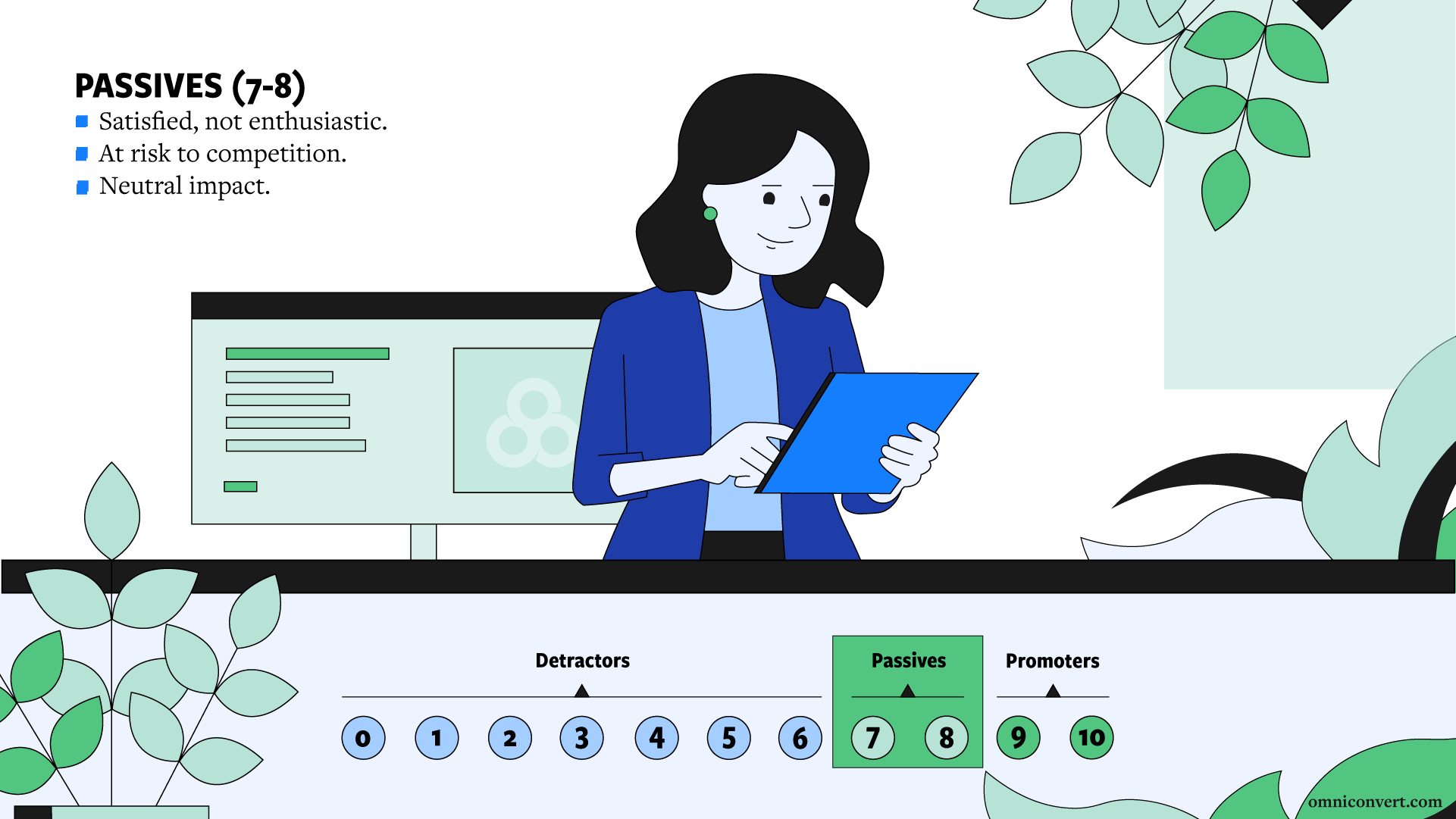
Customers who chose 7-8 on the NPS survey (or 4 for a 5-point survey) fall into the category of Passives.
These people are neither happy nor unhappy customers. They weren’t particularly impressed or disappointed with your brand.
While passives aren’t red flags, they’re still at a high risk of churning. Since there’s no emotional connection to your brand, passives will have no remorse for leaving you for the competition.
Ideally, you should send an additional survey question and discover what was lacking from the passives’ experiences. If it’s an issue you can quickly fix, do so – and bring them to the Promoters’ side.
NPS Detractors
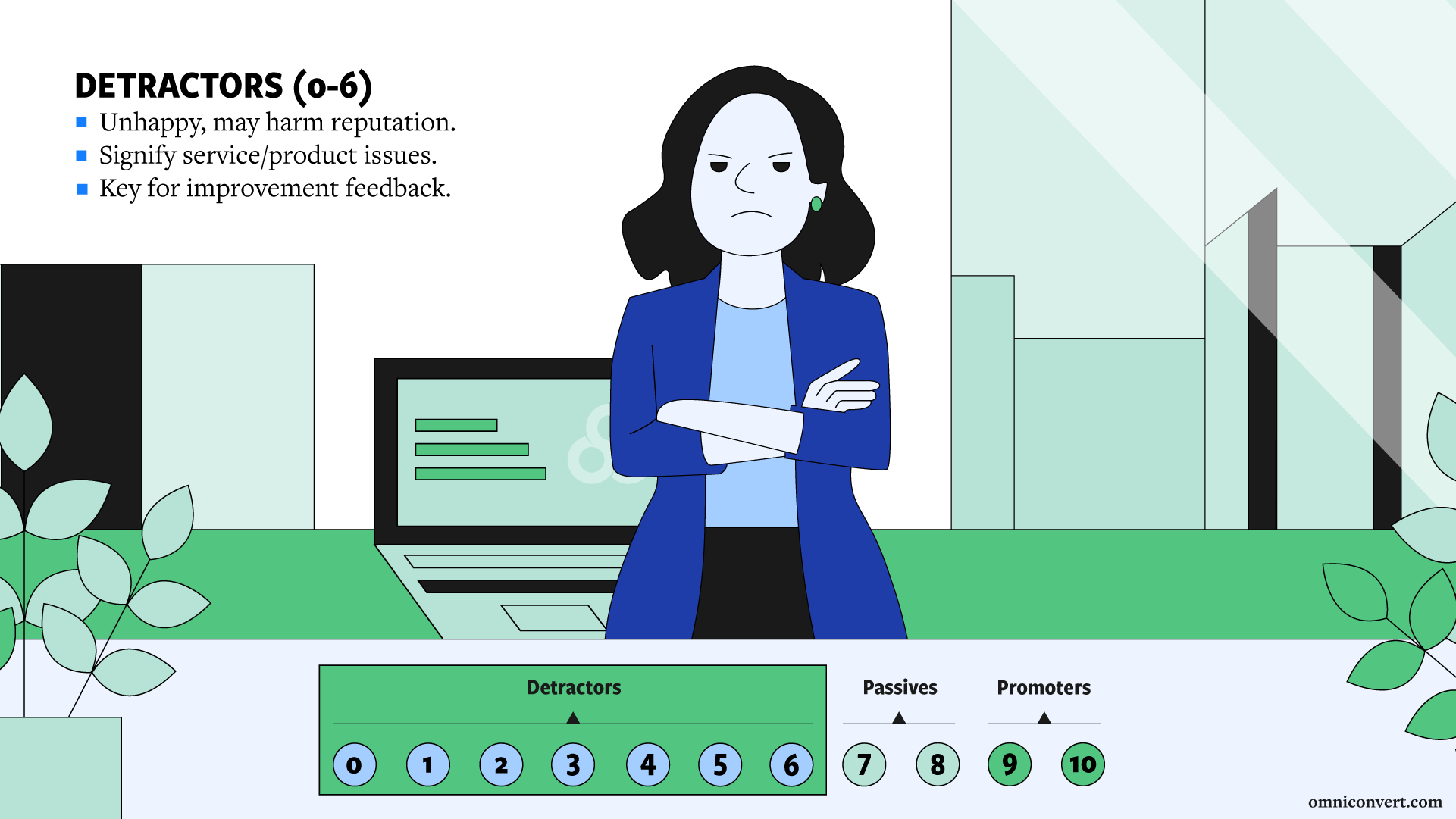
If a customer gives you a score ranging from 1 to 6 (or 1-3 on a 5-point scale), he becomes an NPS Detractor.
Detractors are unhappy customers who feel passionately about your brand. Unfortunately, these people aren’t giving you affection and recommendations. Instead, they might bad month you and impact your overall brand reputation.
According to their place in the RFM segmentation, you want to take action immediately when a customer becomes a detractor.
Some customers require mitigating phone calls from your CX manager, while others can be soothed with emails.
As with the other two NPS groups, Detractors should be further surveyed, so you can recognize what’s lacking from the experiences you’re offering.
The Net Promoter Score is ultimately about being in contact with the voice of the customer. If customers tell you there’s friction inside the customer journey, listen to them – and act accordingly.
How to Calculate NPS
Calculating NPS comes down to a simple mathematical formula, considering each survey response.
After you collect all answers, you need to determine the percentage of detractors, the percentage of passives, and the percentage of promoters.
To do so, you need to subtract from the total responses the number of the other groups, then divide the result by 100.
For example, let’s say you want to identify the percentage of promoters inside your business. For this example, suppose you have a total of 5400 responses, from which 400 are passives, 1000 are promoters, and the rest of 4000 are detractors.
To identify your promoters’ percentage, you subtract 4400 (passives + detractors) from 5400. You would end with 1000, divide it by 100, and get the result: 10% of your customers are promoters.
Using the same values, let’s identify the detractors’ percentage.
Subtract 1400 (passives + promoters) from the total of 5400 responses. The result – 4000 – will be further divided by 100. So, 40% of your customers are detractors.
After determining the values for each group, you calculate the Net Promoter Score by applying the NPS Formula:
NPS = % promoters – % detractors.
For the values from our example, the NPS would be 10% – 40%: -30.
Of course, you don’t need to do the math yourself. You can invest in survey tools such as NPS software, an NPS calculator, or even Excel as a Net Promoter Score calculator.
Check out this detailed guide on calculating the NPS and read about various NPS calculation methods.
How to Interpret the Net Promoter Score
Your Net Promoter Score will always range between -100 and + 100.
When your score is negative, it means your detractors outnumber the promoters. In this case, your customer retention rate will suffer, as unhappy customers are unlikely to ever return for a second purchase.
Conversely, a positive Net Promoter Score suggests you have more promoters than detractors.
This is a good scenario where you offer good experiences, and customers are willing to talk about you and endorse your business to their communities.
Remember that the NPS measures the willingness of recommendation alone and can’t analyze specific aspects of your business. NPS is useful in predicting customer loyalty, but no letter of the law guarantees the prediction is 100% accurate.
If you’re serious about listening to the customers’ voices, combine the NPS survey with another customer satisfaction survey. Research your customer base from multiple POVs to get a holistic image of your brand experience and customer relationship.
Like what you're reading?
Join the informed eCommerce crowd!
We will never bug you with irrelevant info.
By clicking the Button, you confirm that you agree with our Terms and Conditions.
What Is a Good NPS?
At this point, it’s worth mentioning that “good” and “bad” appellatives are misleading and subjective.
The meaning varies from industry to industry, and you can’t allocate definite meanings to your NPS results.
Generally, a positive NPS is a good NPS score, and the higher, the better.
It’s agreed upon that an NPS between 0 and 30 is a good starting point.
If you range above 30 up to 70, you’re doing a great job, and scores above 70 are excellent.
You can measure your NPS against reputable NPS benchmarks inside your industry to get a more accurate view of your situation.
As a bonus feature, benchmarking your NPS provides a direct glimpse into your competitors’ customers. Ultimately, NPS benchmarks show you where you stand compared to your customer’s options.
What Is a Bad NPS?
As a rule of thumb, any score below 0, or negative, is interpreted as indubitably bad. Negative scores mean you have more unhappy customers than satisfied ones. This situation is reflected in high customer churn and renders your acquisition efforts pointless.
When you encounter a negative NPS and identify the reasons behind the scoring, you should clearly understand friction points inside the customer journey. Your game plan for the immediate future is closing the feedback loop by fixing these issues.
Our advice is to send Net Promoter Score surveys, constantly collect customer feedback, and track your progress.
If you act on customer feedback and become intentional about offering better experiences, you should start seeing an improvement in your NPS results.
How to Read Your NPS results
Positive scores reflect a healthy, sustainable business. On the other side of the coin, low scores are wake-up calls, signaling severe trouble that will negatively impact your business in the long term.
Your Net Promoter Score is an irrefutable insight into what the customers think of you and how they perceive your relationship.
An accurate reading of your NPS results should always start with the industry benchmark.
At the same time, if it’s the first time you send out an NPS survey, treat the first results as a baseline from which you can evolve.
As you see an improvement in your NPS results, you should also actively pursue an increase in the response rates. More responses mean more data and more insights about your customers’ experiences.
What Can You Do with Your NPS Score?
As with any other customer experience metric, the beauty behind NPS isn’t in the number itself but in what you can do with the results.
Here are some ideas for things you can accomplish with the insights provided by the NPS.
- Train the customer support teams
Analyzing NPS provides insight into the most common customer issues and complaints. When your detractors mention a problem repeatedly, your customer experience management teams can improve and act on it.
Document the process of fixing the problem, close the feedback loop and use this documentation as a resource for your support teams.
This way, they will have procedures to fix the issues the next time a customer brings it up, thus reducing the waiting time until the problem is resolved.
In the long run, this process will turn support teams into an investment rather than an expense, as they can directly influence the retention rate and overall customer satisfaction.
- Better understand your customer segments.
NPS, on average, doesn’t help much. However, when you combine NPS surveying with customer segmentation, you can break down your customer base into sub-groups and understand them better.
Look for patterns in the responses according to each customer segment.
Do customers report delivery issues in a specific location? Do new passions lack a feature that will move them to a better group? Is there a common issue reported in a new product category?
Repetitive complaints (or requests) highlight the needs of each customer group. This information helps you understand who your customer is, what they need, and how to keep them loyal.
- Earn more WoM
When we discussed passives, we highlighted their churn risk. Flip the coin and look at the opportunity presented by your passives: they can be turned into promoters.
Passives will show you the areas that need looking into and what needs to be done to improve them. Act on the feedback and earn passives’ appreciation and loyalty.
- Decode customer behavior
The Everest of the average marketer is decoding what goes on in customers’ minds. While you might often feel disconnected from your customers, NPS feedback gives a glimpse into what people want.
Think of your most-valued customers: shoppers who spend the most in your shops, return more often, and recommend you to their peers.
These are the people bringing in the revenue, keeping your business afloat, and bringing in new customers.
- You want to acquire more customers like them.
- You want to turn more customers into them.
- And you don’t want to waste resources on people who aren’t them.
NPS insights show what makes these shoppers tick and map out the experiences you need to provide to earn more high-valued customers.
- Improve your products
The NPS use cases aren’t limited to your customer-related teams. Listening to what customers have to say can be beneficial to product teams as well.
When it’s in your power, you can use NPS insights to fix faulty products or invite them as an inspiration when bringing in new products or categories.
Wrap Up
Sometimes we risk deluding that company values, employer culture, or even branding are essential to customers. Yes, all are important and should be a part of the business position and culture.
Yet, if we’re willing, to be honest with ourselves, we will reach the inevitable conclusion that customers only care about how they feel.
They care about a seamless shopping experience, a smooth delivery process, and noticeable progress in their lives.
The NPS scale will show you how close you are to giving customers what they want.
Measure intentionally and update your business model based on what customers want.
Your company will stand out and survive any economic downturn or unfavorable future climate – customers will ensure it.
Frequently Asked Questions about the Net Promoter Score Scale
What is the Scale for NPS?
The Net Promoter Score Scale is the instrument to identify your NPS score. The scale ranges between one and ten, each number corresponding to your customer groups: detractors, passives, and promoters. You can also use a 5-point scale to determine your NPS.
What are the 3 level of ratings in the Net Promoter Score?
The 3 levels of ratings are the Promoters (satisfied customers who scored 9 or 10 on the NPS Scale), the Passives (average customers who scored 7 and 8 on the scale), ant the Detractors (unhappy customers that scored between 1 and 6 on the scale).
What is a good NPS target?
Typically, you’d want to go for a positive NPS. A score between 0 and 30 is considered a good start, from 30 to 70 you’re doing a great job, and anything about 70 is considered exceptional.
What are the 3 categories of NPS?
The three categories of NPS represent customers’ likelihood of recommending your shop. According to their scores, customers fall into these three categories: the Promoters (satisfied customers who scored 9 or 10 on the NPS Scale), the Passives (average customers who scored 7 and 8 on the scale), ant the Detractors (unhappy customers that scored between 1 and 6 on the scale).
How is NPS measured?
NPS is measured through customer surveys. These surveys represent a close-ended questions, asking customers to rate their willingness to recommend your brand on a scale of 1 to 10. Surveys can also contain open-ended questions asking customers to give more details about their answers.
What is NPS scale?
The Net Promoter Score Scale is the instrument to identify your NPS score. Usually, the scale ranges between one and ten, but you can also use a 5-point scale to determine your NPS.
What is a good NPS score?
A score between 0 and 30 is considered a good start, from 30 to 70 you’re doing a great job, and anything about 70 is considered exceptional. However, you should benchmark your NPS agaisnt industry standards to get a more accurate idea.